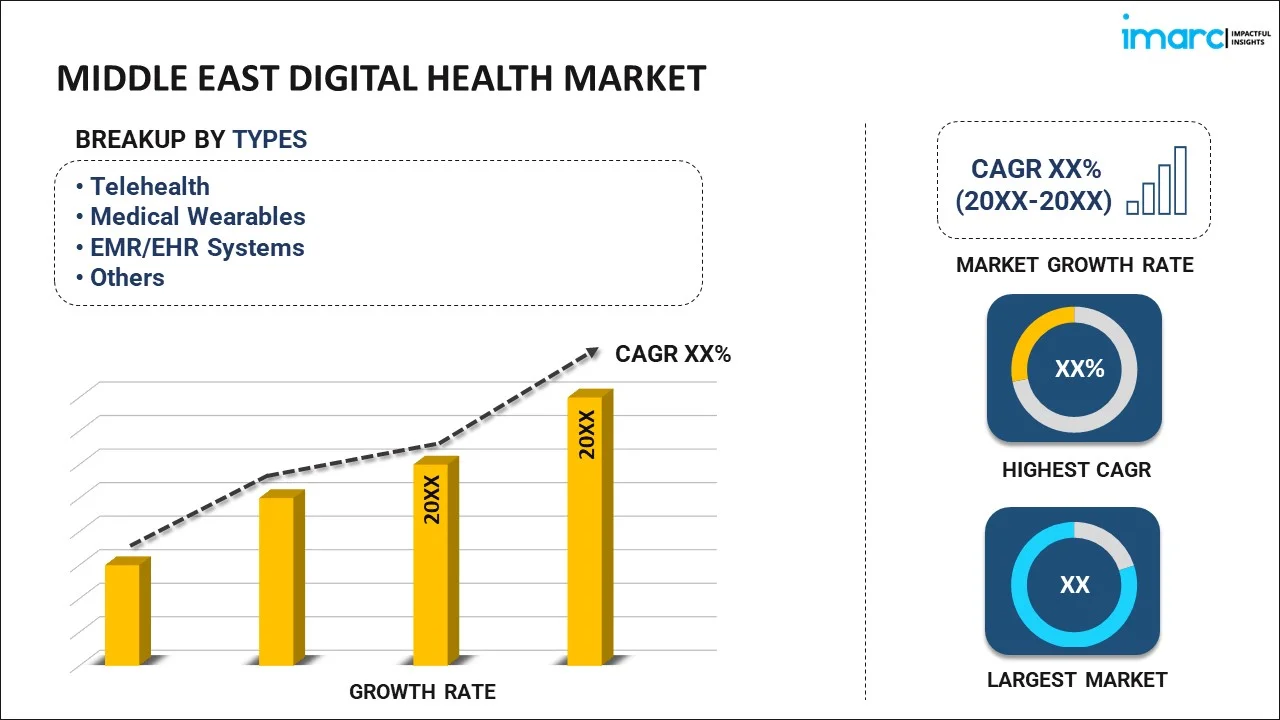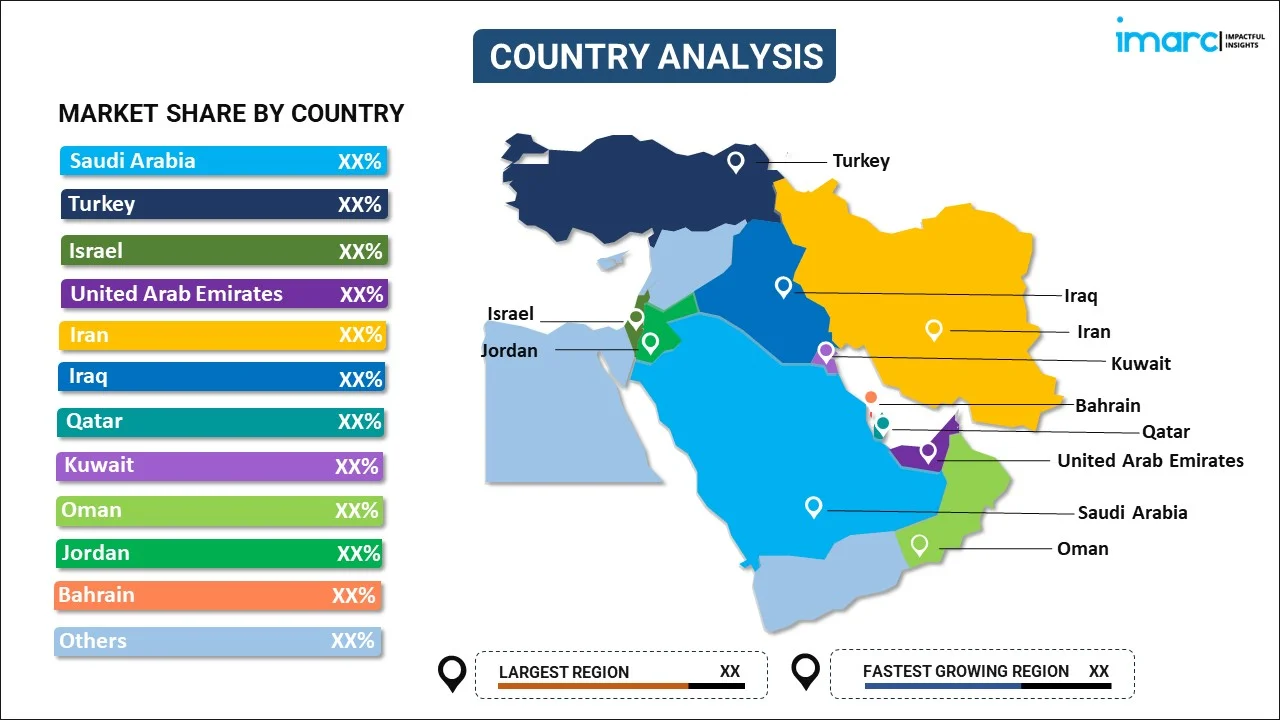
Middle East Digital Health Market Report by Type (Telehealth, Medical Wearables, EMR/EHR Systems, Medical Apps, Healthcare Analytics, and Others), Component (Software, Hardware, Services), and Country 2025-2033
Market Overview:
Middle East digital health market size is projected to exhibit a growth rate (CAGR) of 7.43% during 2025-2033. The widespread utilization of adoption of telehealth and telemedicine services, which enable patients to consult with healthcare providers remotely, thereby improving access to care, is driving the market.
|
Report Attribute
|
Key Statistics
|
|---|---|
|
Base Year
|
2024 |
|
Forecast Years
|
2025-2033
|
|
Historical Years
|
2019-2024
|
| Market Growth Rate (2025-2033) | 7.43% |
Digital health refers to the integration of technology and information to enhance healthcare delivery, patient outcomes, and overall well-being. It encompasses a broad range of digital tools and solutions that leverage advancements such as mobile apps, wearable devices, telemedicine, electronic health records, and data analytics. Digital health aims to improve access to healthcare services, facilitate remote monitoring of patients, and empower individuals to actively manage their health. It also enables healthcare professionals to make more informed decisions through real-time data analysis. The use of digital health technologies can enhance efficiency, reduce healthcare costs, and contribute to more personalized and preventive approaches to medicine. Embracing digital health holds the potential to revolutionize healthcare systems, making them more patient-centered, efficient, and responsive to the evolving needs of individuals and populations.
Middle East Digital Health Market Trends:
The digital health market in the Middle East is propelled by several key drivers, fostering unprecedented growth and innovation in the healthcare industry. Firstly, the increasing adoption of digital technologies in healthcare is transforming traditional patient care models. With the integration of electronic health records (EHRs), telemedicine, and wearable devices, healthcare providers can offer more personalized and efficient services. Moreover, the rising prevalence of chronic diseases has created a demand for remote monitoring and management solutions, stimulating the expansion of the digital health market. Additionally, the regional emphasis on preventive healthcare and wellness programs has incentivized individuals to actively engage with digital health tools for monitoring their health parameters. This shift towards proactive health management not only improves individual well-being but also contributes to the overall reduction in healthcare costs. In parallel, government initiatives and policies promoting the use of digital health technologies have played a pivotal role in shaping the market landscape. These policies encourage the development and implementation of interoperable digital health solutions, fostering a more connected and data-driven healthcare ecosystem. In conclusion, the confluence of technological advancements, changing healthcare needs, and supportive policies converges to drive the remarkable growth of the digital health market in the Middle East.
Middle East Digital Health Market Segmentation:
IMARC Group provides an analysis of the key trends in each segment of the market, along with forecasts at the regional and country levels for 2025-2033. Our report has categorized the market based on type and component.
Type Insights:

- Telehealth
- Medical Wearables
- EMR/EHR Systems
- Medical Apps
- Healthcare Analytics
- Others
The report has provided a detailed breakup and analysis of the market based on the type. This includes telehealth, medical wearables, EMR/HER systems, medical apps, healthcare analytics, and others.
Component Insights:
- Software
- Hardware
- Services
A detailed breakup and analysis of the market based on the component have also been provided in the report. This includes software, hardware, and service.
Country Insights:

- Saudi Arabia
- Turkey
- Israel
- United Arab Emirates
- Iran
- Iraq
- Qatar
- Kuwait
- Oman
- Jordan
- Bahrain
- Others
The report has also provided a comprehensive analysis of all the major regional markets, which include Saudi Arabia, Turkey, Israel, United Arab Emirates, Iran, Iraq, Qatar, Kuwait, Oman, Jordan, Bahrain, and Others.
Competitive Landscape:
The market research report has also provided a comprehensive analysis of the competitive landscape in the market. Competitive analysis such as market structure, key player positioning, top winning strategies, competitive dashboard, and company evaluation quadrant has been covered in the report. Also, detailed profiles of all major companies have been provided.
Middle East Digital Health Market Report Coverage:
| Report Features | Details |
|---|---|
| Base Year of the Analysis | 2024 |
| Historical Period | 2019-2024 |
| Forecast Period | 2025-2033 |
| Units | US$ Million |
| Scope of the Report | Exploration of Historical and Forecast Trends, Industry Catalysts and Challenges, Segment-Wise Historical and Predictive Market Assessment:
|
| Types Covered | Telehealth, Medical Wearables, EMR/EHR Systems, Medical Apps, Healthcare Analytics, Others |
| Components Covered | Software, Hardware, Services |
| Countries Covered | Saudi Arabia, Turkey, Israel, United Arab Emirates, Iran, Iraq, Qatar, Kuwait, Oman, Jordan, Bahrain, Others |
| Customization Scope | 10% Free Customization |
| Report Price and Purchase Option | Single User License: US$ 3699 Five User License: US$ 4699 Corporate License: US$ 5699 |
| Post-Sale Analyst Support | 10-12 Weeks |
| Delivery Format | PDF and Excel through Email (We can also provide the editable version of the report in PPT/Word format on special request) |
Key Questions Answered in This Report:
- How has the Middle East digital health market performed so far and how will it perform in the coming years?
- What has been the impact of COVID-19 on the Middle East digital health market?
- What is the breakup of the Middle East digital health market on the basis of type?
- What is the breakup of the Middle East digital health market on the basis of component?
- What are the various stages in the value chain of the Middle East digital health market?
- What are the key driving factors and challenges in the Middle East digital health?
- What is the structure of the Middle East digital health market and who are the key players?
- What is the degree of competition in the Middle East digital health market?
Key Benefits for Stakeholders:
- IMARC’s industry report offers a comprehensive quantitative analysis of various market segments, historical and current market trends, market forecasts, and dynamics of the Middle East digital health market from 2019-2033.
- The research report provides the latest information on the market drivers, challenges, and opportunities in the Middle East digital health market.
- Porter's five forces analysis assist stakeholders in assessing the impact of new entrants, competitive rivalry, supplier power, buyer power, and the threat of substitution. It helps stakeholders to analyze the level of competition within the Middle East digital health industry and its attractiveness.
- Competitive landscape allows stakeholders to understand their competitive environment and provides an insight into the current positions of key players in the market.
Need more help?
- Speak to our experienced analysts for insights on the current market scenarios.
- Include additional segments and countries to customize the report as per your requirement.
- Gain an unparalleled competitive advantage in your domain by understanding how to utilize the report and positively impacting your operations and revenue.
- For further assistance, please connect with our analysts.
 Inquire Before Buying
Inquire Before Buying
 Speak to an Analyst
Speak to an Analyst
 Request Brochure
Request Brochure
 Request Customization
Request Customization




.webp)




.webp)












